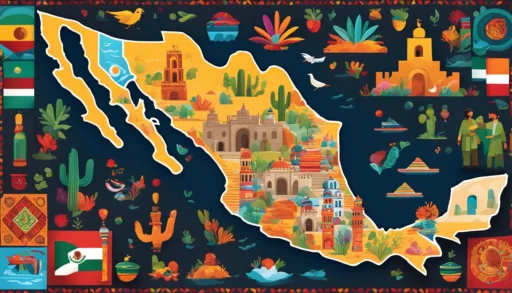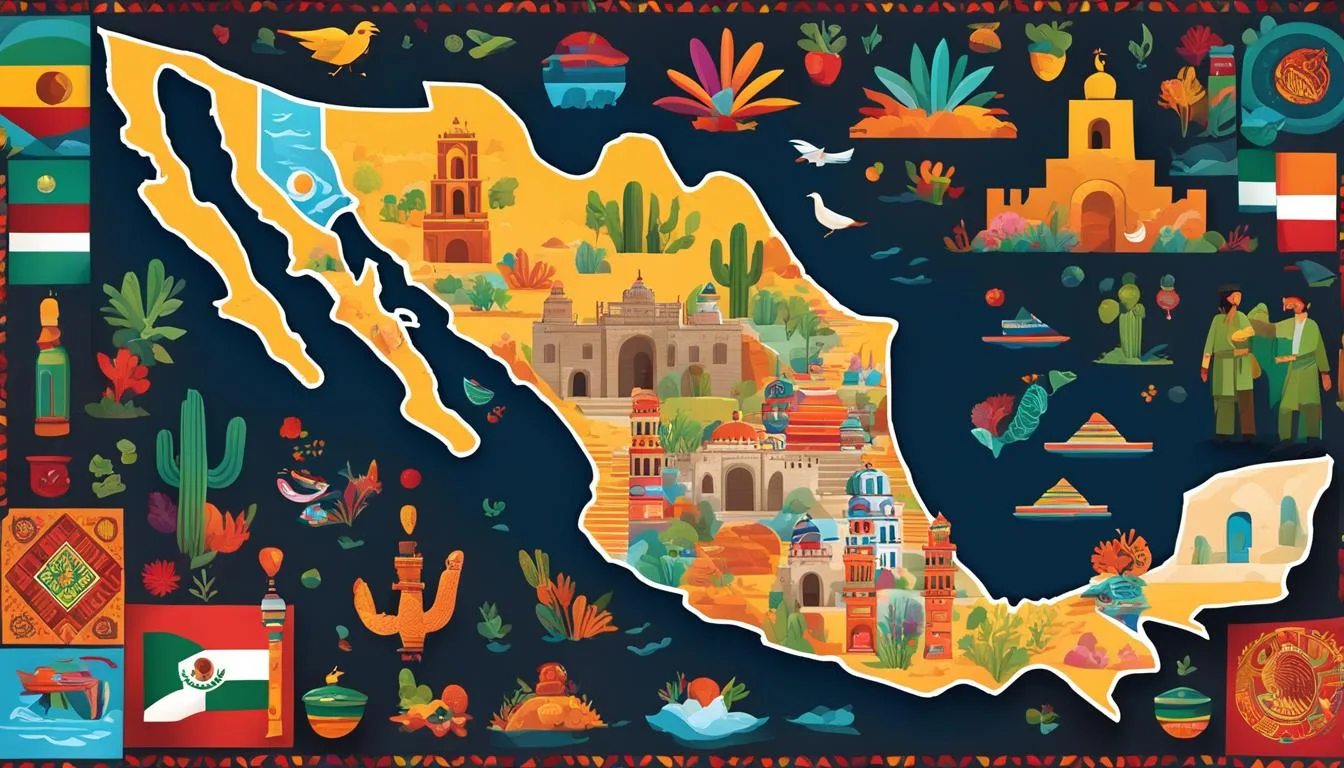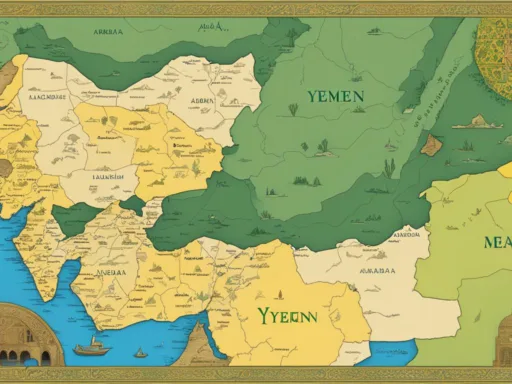Did you know that Mexico, a nation known for its vibrant colors and flavours, is also a kaleidoscope of linguistic diversity? Beyond the commonly spoken Spanish language, this cultural powerhouse revels in a remarkable spectrum, with 68 official indigenous linguistic groups recognized by the Mexican government. Moreover, there are 364 distinct varieties within these groups, showcasing an astonishing level of linguistic diversity Mexico proudly sustains. Every street corner, every tradition, and every melody in Mexico whispers stories in a library of tongues, illustrating the rich tapestry of languages spoken in Mexico. Dive into the heart of Mexican language diversity and discover the voices that have shaped a nation.
Key Takeaways
- Spanish is the de facto national language of Mexico, without an official status.
- Mexico’s linguistic landscape includes 68 indigenous linguistic groups and 364 varieties.
- Languages such as Nahuatl and Yucatec Mayan are among the widely spoken indigenous languages.
- Mexico’s cultural heritage is deeply intertwined with its rich linguistic diversity.
- Understanding the linguistic fabric of Mexico provides insight into its history and cultural identity.
The Predominance of Spanish in Mexico
In the mosaic of languages that comprise the cultural fabric of Mexico, Spanish reigns as the most pervasive mode of communication, unifying the nation under a common tongue. Despite the absence of an official declaration, Spanish operates as the de facto linguistic standard, permeating all facets of Mexican society. This centrality of Spanish is not merely a reflection of contemporary practices but also a historical narrative that echoes the linguistic evolution of the country since the colonial era.
Spanish as the de facto National Language
With over 90% of Mexicans fluent in Spanish, the language’s extensive usage situates Mexico as the most populous Spanish-speaking country on the globe. This linguistic reality is not by chance but rather by design, as Spanish forms the core medium for government proceedings, educational discourse, and mass media. The longstanding tradition of operating in Spanish for official matters further solidifies its standing as the central pillar of communication, integral to the nation’s identity.
Spanish Dialects Unique to Mexico
The ever-present sounds of Spanish across Mexico are not monolithic; rather, they are marked by an array of dialects and sociolects unique to the Mexican context. These variants are the byproducts of the vibrant blend between the Spanish brought by the conquerors, the Latin used by the clergy, and the rich tapestry of indigenous tongues that have shaped the phonetic and lexical characteristics of Mexican Spanish. Such diversity paints a picture of a language that is as multifaceted as the people who speak it, embodying the authentic linguistic diversity that is a hallmark of Mexican culture.
Languages Spoken Mexico: A Look at Diversity Beyond Spanish
Exploring the linguistic diversity Mexico boasts goes much deeper than its dominant Spanish language. Mexico is a country teeming with a rich tapestry of languages, reflecting its complex history and cultural fabric. Amidst the widely spoken Spanish, there exists a vibrant mosaic of languages speaking to the heart of Mexico’s heritage.
Integral to the Mexican language diversity are the indigenous languages that have been communicated for centuries, if not millennia. These languages, with their varied phonetic and syntactic structures, offer an auditory glimpse into the past civilizations that shaped modern Mexico. Let’s delve into some of these languages and their significance:
- Nahuatl: Once the lingua franca of the mighty Aztec Empire, today it still flows from the tongues of over a million speakers.
- Yucatec Maya: Alive in the Yucatán Peninsula, this language serves not only as a means of communication but as a living relic of the ancient Mayans.
- Mixtec: This group of languages, with numerous dialects, reflects the cultural richness of the Mixtec people.
- Zapotec: Its web of varieties is a testament to the adaptability and resilience of indigenous cultures in Oaxaca.
The following table reveals the geographical distribution and number of speakers for these emblematic languages, underscoring the linguistic diversity Mexico nurtures within its borders:
| Language | Number of Speakers | Primary Regions Spoken |
|---|---|---|
| Nahuatl | 1.5 million | Guerrero, Puebla, Hidalgo |
| Yucatec Maya | 800,000 | Yucatán Peninsula |
| Mixtec | 500,000 | Oaxaca, Guerrero, Puebla |
| Zapotec | 425,000 | Oaxaca |
The continued use and promotion of these languages signify a broader commitment to preserving and celebrating Mexican language diversity. While globalization poses challenges, the enduring presence of indigenous languages echoes a collective resolve to hold onto linguistic roots that proudly narrate Mexico’s ongoing story.
Linguistic Diversity and Indigenous Languages Mexico
The tapestry of indigenous languages Mexico boasts is not just a testament to its rich history, but also a beacon of cultural identity in the present day. With each indigenous language comes a universe of traditions, expressions, and worldviews, many of which are continuously echoed through speech and writing by communities that cherish their ancestral heritage. Language preservation in Mexico is therefore not just an academic endeavor, but a crucial aspect of sustaining the vibrant fabric of this nation’s cultural diversity.
Nahuatl: The Language of the Aztecs
Nahuatl, an indigenous language that traces back to the mighty Aztec civilization, thrives in modern-day Mexico with over a million speakers. Its resilience and proliferation serve as evidence of the Mexican people’s dedication to honoring and preserving their historic languages. It flourishes not only in the rural communities but also finds its echoes in Mexican urban life, proving the language’s adaptability and continued relevance.
Yucatec Maya and Other Mayan Languages
The Yucatec Maya language, along with other Mayan languages such as Tzeltal and Tzotzil, continues to be spoken by hundreds of thousands of individuals, predominantly in the Yucatán Peninsula. These languages, with their unique phonological systems and complex grammatical structures, are integral to the cultural tapestry and social practices of the Mayan peoples. Efforts to document and promote these languages are part of ongoing initiatives to ensure they flourish.
Preserving the Languages of Mexico’s Ancestral Peoples
Preservation of Mexico’s linguistic heritage is critical in the face of globalization and modernization. Diverse initiatives, from governmental programs to local community projects, aim to support the teaching and learning of languages such as Nahuatl and Yucatec Maya. These initiatives are not merely about conserving a means of communication but about maintaining a living bridge to the intellectual and social practices of past civilizations.
| Language | Speaker Estimate | Key Regions | Writing Systems |
|---|---|---|---|
| Nahuatl | Over 1 million | Central Mexico | Latin alphabet, Historical glyphs |
| Yucatec Maya | Hundreds of thousands | Yucatán Peninsula | Latin alphabet, Pre-Columbian Maya script |
| Tzeltal and Tzotzil | Various estimates | Chiapas | Latin alphabet |
The pursuit of language preservation for these ancient tongues is a testament to a nation’s unwavering commitment to cultural integrity and diversity. It is through this dedication that the profound voices of Mexico’s ancestral peoples continue to resonate across landscapes and generations.
The Status of Indigenous Languages Today
In the heart of Mexico’s vibrant cultural tapestry, the significance of maintaining linguistic diversity cannot be overstated. As the world becomes increasingly globalized, indigenous languages carry the torch of Mexico’s cultural heritage, and their continued existence is a testament to the nation’s rich history and identity. Against the backdrop of modernity, these languages are popular connections to the past, woven into the daily lives and communities across Mexico.
Efforts to Protect Endangered Languages
Mexico has taken firm strides in enacting legal frameworks like the General Law of Linguistic Rights of the Indigenous Peoples, aiming to safeguard the native tongues that echo through its vast landscapes. These laws seek to grant the nation’s indigenous languages legal standing on par with Spanish, symbolizing a commitment to linguistic equality and diversity. Yet, the reality remains a delicate balance, as many of these languages dangle on the brink of extinction, inching perilously close to becoming whispers of a bygone era.
Bilingual Education and Cultural Heritage
Embracing the complexity of Mexico’s linguistic roots, there has been a vigorous championing of bilingual education. This form of education is not just a pedagogical model; it’s a bridge that connects generations, encouraging the younger populace to inherit and perpetuate the linguistic and cultural wealth of their ancestors. Whether it’s within classroom walls or the tranquility of home, bilingualism is the beacon that guides Mexico in preserving its timeless cultural heritage.
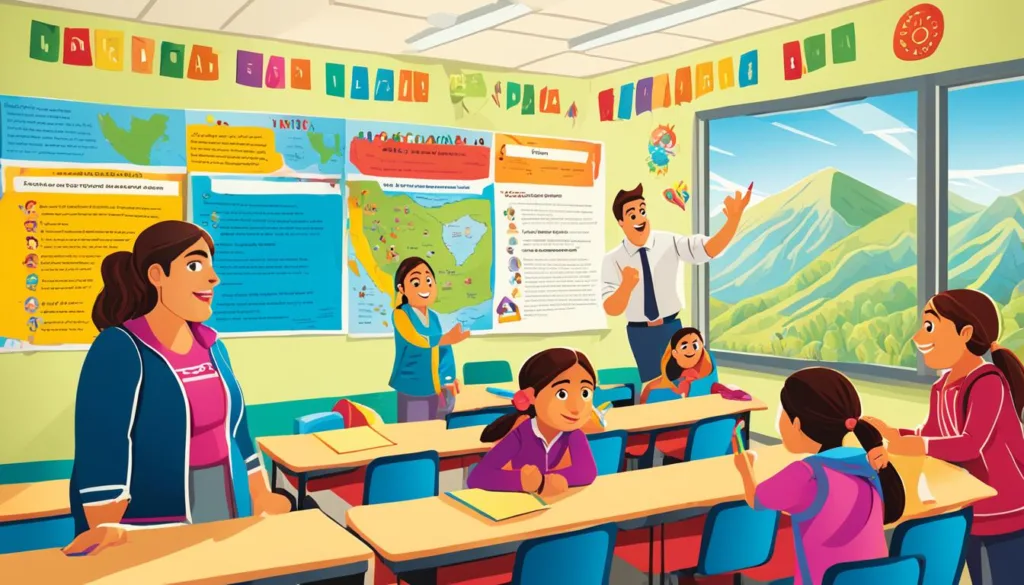
Insights into the status of popular languages in Mexico can be illuminated through the following table, which contrasts the statistics of speaker growth and the implementation of bilingual education initiatives across various regions.
| Indigenous Language | Number of Speakers | Annual Growth | Bilingual Education Programs |
|---|---|---|---|
| Nahuatl | 1,725,000 | 0.9% | Regionally focused, expanding |
| Yucatec Maya | 795,000 | 1.2% | Comprehensive in Yucatán Peninsula |
| Chiapas Zoque | 60,000 | -0.5% | Limited, with ongoing development |
| Mixtec | 511,000 | 0.7% | Community-led initiatives |
The tapestry of Mexico’s cultural heritage is a colorful confluence of history, people, and language. The ongoing challenge is to balance pride in a nation’s past with proactive strategies for its future. It is through such measures—statutes that affirm linguistic rights, and education systems that embolden bilingualism—that Mexico can hope to truly honor and sustain the indigenous voices that resonate at its core.
Mexico Language Map: Geographical Distribution of Languages
The intricate tapestry of Mexico’s linguistic heritage is vividly illustrated in the Mexico language map, outlining the rich variety of languages that pepper the nation’s landscape. From the Yucatec Maya in the verdant Yucatán Peninsula to the widespread Nahuatl, the contours of Mexico’s language distribution tell the story of its enduring indigenous cultures and historical dimensions.
Linguistic hotspots can be found particularly in Mexico’s southern regions where indigenous communities maintain their ancestral languages. To understand the complexity and diversity of language distribution in Mexico, let’s delve into a detailed overview:
| Language | Primary Regions | Notable Features |
|---|---|---|
| Nahuatl | Spread across multiple states including Veracruz, Puebla, and Hidalgo | Known as the language of the Aztecs, it’s one of the most spoken indigenous languages in Mexico. |
| Yucatec Maya | Yucatán Peninsula, including the states of Yucatán, Quintana Roo, and Campeche | A Mayan language that has survived centuries and is emblematic of the rich Mayan cultural heritage. |
| Tzeltal and Tzotzil | Chiapas | Relates to the deep roots these communities have in the highlands region of Chiapas. |
| Zendal (Zapoteco) | Oaxaca | A language group with numerous variants, reflecting the diverse cultures within the state of Oaxaca. |
| Rarámuri (Tarahumara) | Chihuahua | Spoken by the Rarámuri people, known for their long-distance running abilities and distinctive culture. |
| Yoeme (Yaqui) | Sonora | Language of the Yaqui people, recognized for their rich tradition of folklore and dance. |
| Mixtec | Principally in Oaxaca, Guerrero, and Puebla | Includes an array of linguistic variants that mirror the region’s complex ethnolinguistic landscape. |
A closer examination of the Mexico language map does more than just showcase the geographical spread; it emphasizes the historical significance and influence these languages have had on the culture, tradition, and even the modern Spanish spoken within the nation’s borders.
Understanding the crisscrossing of languages through such a map not only connects us with Mexico’s past but also sheds light on the contemporary challenges and triumphs in preserving and revitalizing these linguistic treasures. It’s a living document, charting the vibrancy and resilience of Mexico’s diverse linguistic heritage.
The Influence of Mexico’s Linguistic Heritage on Spanish
The tapestry of languages in Mexico has not only shaped the cultural identity of the nation but has also left its mark on the evolution of the Spanish language. The profound Mexican Spanish influence extends beyond mere linguistic interaction, forming a body of language distinct in vocabulary and pronunciation. As a result of this rich linguistic heritage Mexico has become known for, the version of Spanish spoken in the country today is rife with impressions from its indigenous roots.
Indigenous Contributions to Mexican Spanish Vocabulary
Many commonly used Mexican Spanish terms owe their origin to the country’s indigenous tongues, providing a flavorful lexicon that enhances everyday communication. These words reflect the quotidian aspects of Mexican life and have been universally adopted into the Spanish vernacular.
- Chocolate from the Nahuatl word xocolātl, which translates to “bitter water.”
- Tomate derived from the Nahuatl word tomatl, indicating the now ubiquitous tomato.
- Chile, the hot pepper integral to Mexican cuisine, from the Nahuatl chīlli.
This linguistic exchange has been a two-way process, with the Spanish language also imparting various grammatical structures and vocabularies to the native languages, further enriching the linguistic landscape of Mexico.
Historical Blending of Languages in Mexico
The intersection of languages throughout Mexico’s history has been significantly impacted by pivotal events and key historical figures. The arrival of Spanish conquistadors and the subsequent establishment of Catholic missions brought about an indispensable blending of linguistic and cultural elements.
This merging of languages over the centuries developed a unique variant of Spanish that can be distinctly heard throughout the country today and contrasts sharply with Spanish dialects heard around the world. Here, the union of indigenous and colonial languages has fostered a unique communication style, both in word and intonation.
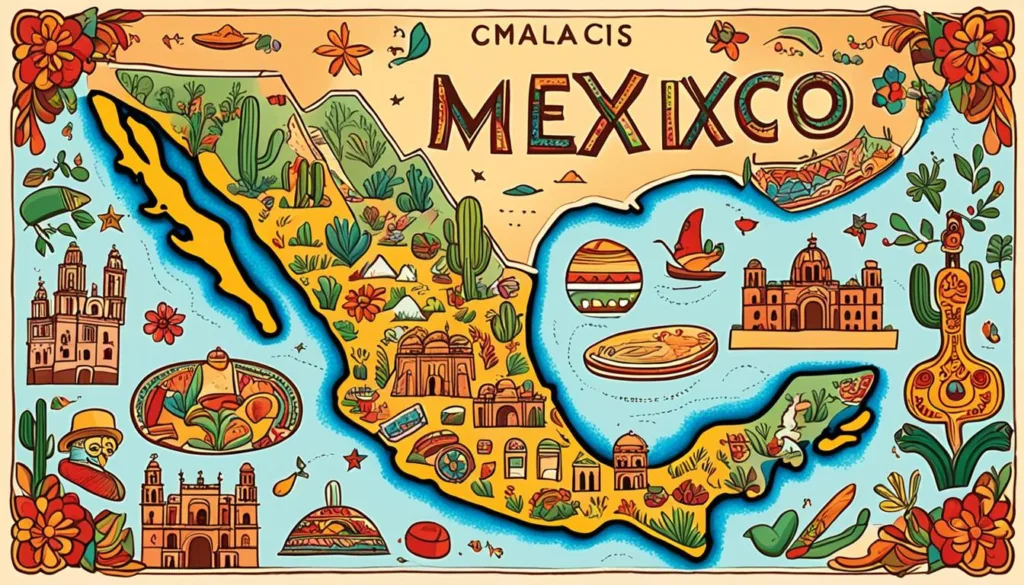
| Indigenous Word | Spanish Translation | Modern Use in Mexican Spanish |
|---|---|---|
| Ahuacatl (Nahuatl) | Avocado | Used as is, refers to the fruit and cultural staple, the avocado |
| Metate (Nahuatl) | Grinding stone | Refers to the traditional stone platform used for grinding corn and other foods |
| Guajolote (Nahuatl) | Turkey | Common term for turkey, hinting at its pre-Columbian roots |
| Petate (Nahuatl) | Woven mat | Designates the handwoven mats traditionally made for sleeping |
These examples illustrate the enduring legacy and continuing influence that the linguistic wealth of Mexico imprints on the fabric of the nation’s dialogue and traditions. The fusion of linguistic nuances reflects the enduring richness of Mexico’s cultural and linguistic heritage.
Official Languages in Mexico: Legal Recognition and Challenges
In navigating the linguistic landscape of Mexico, one encounters a complex interplay of culture and legislation. Spanish stands as the lingua franca, seamlessly merged into the fabric of Mexican life, yet beneath this layer lies a vibrant mosaic of indigenous tongues, each echoing the country’s multicultural identity. These languages, integral to the social and cultural framework, are backed by legal recognition which aims to preserve their existence amidst a modernizing nation.
Constitutional Recognition of Mexico’s Multicultural Identity
The Mexican Constitution is a testament to the nation’s respect for linguistic pluralism and cultural diversity. It acknowledges the invaluable heritage of indigenous peoples and promotes the preservation and enrichment of their languages. This constitutional respect sets the foundation for a society that values each voice within its diverse chorus, ensuring linguistic rights are enshrined at the highest level of law.
Language Policies in Education and Governance
Infused with the drive to celebrate and sustain its rich linguistic repertoire, Mexico has instituted policies that reflect a commitment to bilingual and intercultural education. These initiatives aim to provide students with the skills and knowledge to participate fully in a multi-lingual society and to respect the cultural contributions of all its constituents. However, the enforcement of these policies often encounters obstacles, stemming from their very complexity and the broad scope of languages they aim to support.
| Policy | Purpose | Impact |
|---|---|---|
| General Law of Linguistic Rights of the Indigenous Peoples | Grant indigenous languages equal validity as Spanish in their respective territories | Increased visibility and use of indigenous languages in official capacities |
| National Institute of Indigenous Languages (INALI) | Promote and protect the linguistic rights of indigenous peoples | Supports language revitalization efforts and documentation projects |
| Intercultural Bilingual Education Programs | Integrate knowledge and respect for indigenous cultures into the national curriculum | Improves educational outcomes for indigenous students and raises cultural awareness |
Despite the challenges that the promotion and implementation of these language policies may entail, their existence is pivotal in Mexico’s endeavor to honor its indigenous communities and safeguard cultural legacy. Language policies in Mexico continue to be refined and adapted, heeding to the evolving needs of its people and the overarching aim of fostering a society inclusive of its profound linguistic richness.
Global Influences: The Role of English and Other Foreign Languages
As Mexico navigates the dynamic currents of cultural exchange, the influence of global languages, especially English, is shaping the nation’s linguistic panorama. This rise in the prevalence of foreign languages can be attributed to close economic ties with international markets, an increase in mobility due to tourism, and the pull of pop culture. Particularly among the youth and in business sectors, bilingualism in Mexico is not just a cultural phenomenon but an economic imperative.

The Impact of Tourism on Language Use in Mexico
The allure of Mexico’s picturesque beaches and historic cities attracts millions of tourists each year, instituting English as a vital tool for communication. Hospitality workers, tour guides, and local artisans have adapted to cater to this boom, often incorporating English phrases into their daily interactions. This linguistic shift is notably observable in destinations such as Cancun and Playa del Carmen, where international visitors are a defining presence.
Border English and Bilingualism
Border states present a unique blend of language use, where the exchange between Mexico and the United States fosters a culture of bilingualism. English proficiency becomes a bridge, facilitating cross-border business and fostering unique Spanglish vernaculars that highlight the fluid nature of languages. This hybrid language use underscores the deep-rooted impact of global influences Mexico has embraced. Moreover, the need for English language skills in Mexico is becoming increasingly important as many sectors, particularly tourism and international business, often require employees to be bilingual to effectively engage with global partners.
Popular Languages Mexico: The Urban and International Mix
The linguistic repertoire of Mexico extends beyond its borders, embracing an array of popular languages Mexico through its bustling metropolises and international engagement. As migrants and expatriates make their way into Mexico’s urban centers, they contribute to the polyglot character of the country. This vibrant mix not only highlights the global connectivity of Mexican cities but also reflects the country’s cultural openness and adaptability.
English, without doubt, leads as the most prevalent foreign language across Mexico, serving as a bridge between locals and the English-speaking expat communities. Its utility is magnified in the business sectors and in areas with high volumes of international tourism. Yet, the linguistic landscape is colored by more than just English:
- Italian – with hearty communities contributing to cultural and culinary scenes
- French – echoing historical ties and contemporary artistic exchanges
- Portuguese – growing in presence due to Brazil’s economic and cultural ties
- Greek – marking small yet vibrant communities within Mexico
- Asian languages – including Mandarin, Korean, and Japanese, accompanying business and cultural exchanges
These languages represent not just the people who speak them but also symbolize the globalized pulse of modern Mexican society. Yet, it is important to acknowledge that within each urban center, the fluency and prevalence of these languages can vary greatly. Areas with multinational corporations may have a higher concentration of professionals with multilingual capabilities, while cultural pockets within cities often cultivate the languages of their heritage.
“Mexico’s cities are mosaics of language, demonstrating both historical depth and modern globalization. Each community adds a different hue, creating a picture that is distinctly Mexican yet globally resonant.”-Extract from a local cultural anthropologist’s lecture
The presence of these languages enhances Mexico’s rich tapestry of human expression, ensuring the nation remains a significant crossroads of global cultures. As Mexico continues to open its doors to the world, the urban and international mix of languages promises to grow and evolve, contributing to the country’s dynamic and diverse linguistic identity.
Conclusion
The mosaic that is Mexico’s linguistic heritage continues to present a vibrant and evolving palette, reflective of a nation deeply rooted in cultural richness and diversity. Navigating through the confluence of languages brought forth by globalization and historical legacy, Mexico stands at the cusp of preserving an invaluable linguistic treasure trove. The country’s engagement with both the enduring presence of Spanish and the invaluable contribution of indigenous tongues sets the stage for an enriching cultural narrative well into the future.
The Future of Mexico’s Linguistic Landscape
Looking ahead, the future of Mexico’s language scene is shaped by a dynamic interplay between tradition and modernity. As international cultural currents flow into the country, they are met with a steadfast commitment to uphold the multiplicity of local and indigenous expressions. This dedication is crucial, ensuring that the linguistic tapestry not only retains but also celebrates its unique patterns. Bilingual education initiatives and protective legislative frameworks are pivotal in championing this cause, nurturing a space where languages old and new can flourish.
Importance of Language Preservation for Cultural Identity
In the realm of cultural preservation, language stands as a testament to identity and heritage. Mexico’s resolve in safeguarding its linguistic diversity is a cornerstone for maintaining the nation’s collective identity. Language preservation in Mexico has become synonymous with upholding the country’s soul, allowing future generations to access, appreciate, and contribute to the cultural wisdom encoded within each spoken word. Mexico’s storied past and its forward-looking initiatives coalesce to fortify a world rich in language and heritage for years to come.
FAQ
What languages are spoken in Mexico?
Mexico is characterized by a rich linguistic landscape with Spanish being the de facto national language. There are also sixty-eight recognized indigenous linguistic groups, including languages such as Nahuatl, Yucatec Maya, Mixtec, and Zapotec. English and other foreign languages are also spoken, particularly in tourist areas and larger cities.
Is Spanish the official language of Mexico?
While there is no declared official language in Mexico, Spanish functions as the national language spoken by the majority of the population. The Mexican government recognizes the right of indigenous peoples to use their own languages, alongside Spanish, in their respective territories.
Are there unique Spanish dialects in Mexico?
Yes, Mexican Spanish includes a variety of regional dialects and sociolects influenced by indigenous languages and historical factors. These dialects can vary significantly across different parts of the country.
How many indigenous languages are spoken in Mexico?
Mexico officially recognizes sixty-eight indigenous linguistic groups and over 350 language varieties. Some of the most widely spoken indigenous languages include Nahuatl, Yucatec Maya, Mixtec, and Zapotec.
What is being done to preserve indigenous languages in Mexico?
Mexico has implemented legal provisions like the General Law of Linguistic Rights of the Indigenous Peoples. Additionally, there are ongoing efforts to promote bilingual and intercultural education, and various initiatives are in place to document and revitalize indigenous languages.
Can you find a Mexico language map showing the distribution of languages?
Yes, there are Mexico language maps available that illustrate the geographical distribution of different languages throughout the country, indicating the regions where indigenous languages and Spanish dialects are predominantly spoken.
How have indigenous languages influenced Mexican Spanish?
Indigenous languages have enriched Mexican Spanish, contributing numerous words to its vocabulary. This has occurred through historical interactions over centuries, reflecting the blending of native cultures with Spanish influence.
What languages are taught in Mexican schools?
Spanish is the primary language of instruction in Mexican schools. However, there is an increasing focus on bilingual and intercultural education programs, particularly in regions with significant indigenous populations, where students are also taught in native languages.
How extensive is English spoken in Mexico?
English is widely spoken in Mexico’s border states and tourist destinations. It is often used in business, education, and by those working in the tourism industry. Spanglish, a blend of Spanish and English, is also common in these areas.
What foreign languages are popular in Mexican urban centers?
Aside from English, other popular foreign languages spoken in Mexico’s urban centers include Italian, Portuguese, French, and various Asian languages, reflecting Mexico’s diverse international connections.
What is the future of Mexico’s linguistic landscape?
The future of Mexico’s linguistic landscape is expected to maintain its diversity and complexity, with ongoing preservation efforts for indigenous and Spanish languages, as well as adaptations due to globalization and tourism.
